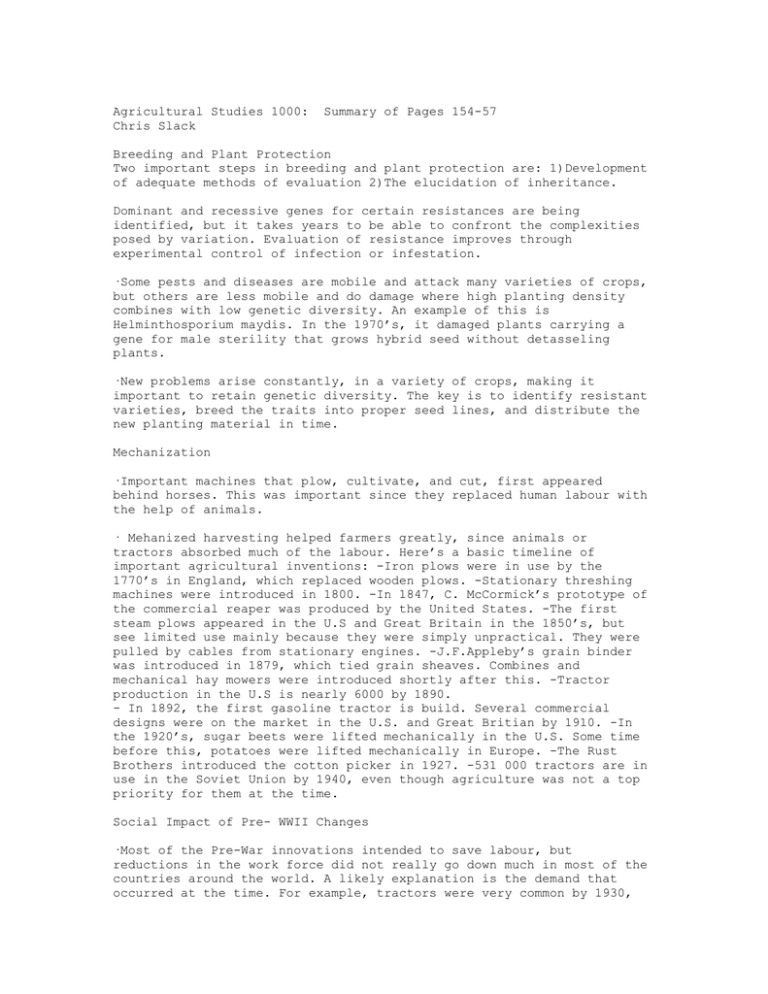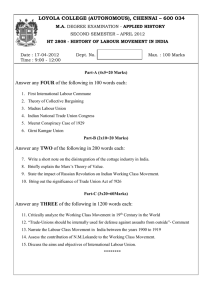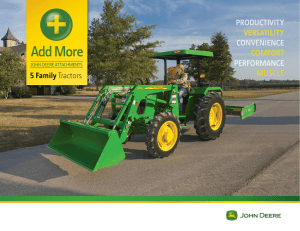Agricultural Studies 1000: Summary of Pages 154-57 Chris Slack
advertisement

Agricultural Studies 1000: Chris Slack Summary of Pages 154-57 Breeding and Plant Protection Two important steps in breeding and plant protection are: 1)Development of adequate methods of evaluation 2)The elucidation of inheritance. Dominant and recessive genes for certain resistances are being identified, but it takes years to be able to confront the complexities posed by variation. Evaluation of resistance improves through experimental control of infection or infestation. ·Some pests and diseases are mobile and attack many varieties of crops, but others are less mobile and do damage where high planting density combines with low genetic diversity. An example of this is Helminthosporium maydis. In the 1970’s, it damaged plants carrying a gene for male sterility that grows hybrid seed without detasseling plants. ·New problems arise constantly, in a variety of crops, making it important to retain genetic diversity. The key is to identify resistant varieties, breed the traits into proper seed lines, and distribute the new planting material in time. Mechanization ·Important machines that plow, cultivate, and cut, first appeared behind horses. This was important since they replaced human labour with the help of animals. · Mehanized harvesting helped farmers greatly, since animals or tractors absorbed much of the labour. Here’s a basic timeline of important agricultural inventions: -Iron plows were in use by the 1770’s in England, which replaced wooden plows. -Stationary threshing machines were introduced in 1800. -In 1847, C. McCormick’s prototype of the commercial reaper was produced by the United States. -The first steam plows appeared in the U.S and Great Britain in the 1850’s, but see limited use mainly because they were simply unpractical. They were pulled by cables from stationary engines. -J.F.Appleby’s grain binder was introduced in 1879, which tied grain sheaves. Combines and mechanical hay mowers were introduced shortly after this. -Tractor production in the U.S is nearly 6000 by 1890. - In 1892, the first gasoline tractor is build. Several commercial designs were on the market in the U.S. and Great Britian by 1910. -In the 1920’s, sugar beets were lifted mechanically in the U.S. Some time before this, potatoes were lifted mechanically in Europe. -The Rust Brothers introduced the cotton picker in 1927. -531 000 tractors are in use in the Soviet Union by 1940, even though agriculture was not a top priority for them at the time. Social Impact of Pre- WWII Changes ·Most of the Pre-War innovations intended to save labour, but reductions in the work force did not really go down much in most of the countries around the world. A likely explanation is the demand that occurred at the time. For example, tractors were very common by 1930, but because of the depression total farm labour hours decreased only slightly from the 1920’s. ·During the depression, larger per-capita demand for meat, dairy, and other land-consuming products resulted in expansion of the markets. ·Increased labour trends resulted in expansion of farm areas in North America and Australia. In France and Germany, the farm work force increases marginally, but in the United Kingdom, it declined 38% from 1861 to 1911. In places like Prussia, land reforms such as breaking up large holdings, resulted in decreased concentration.






